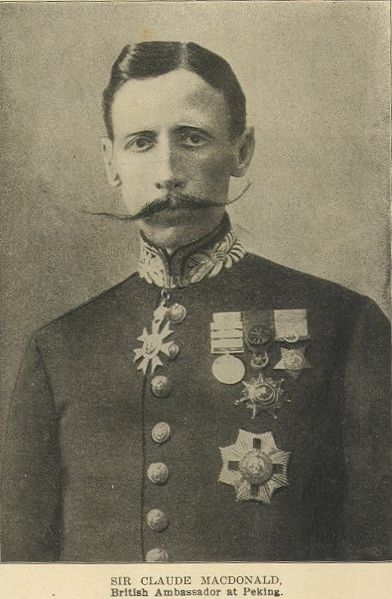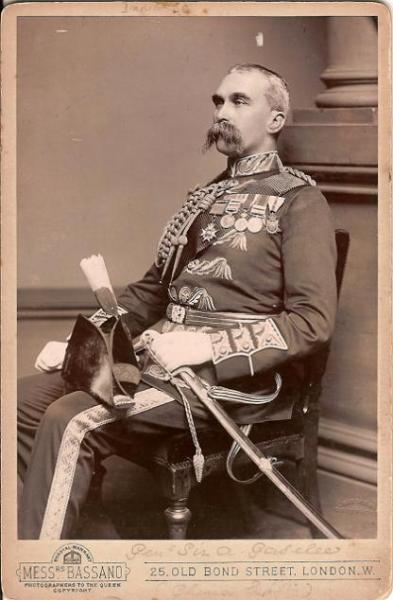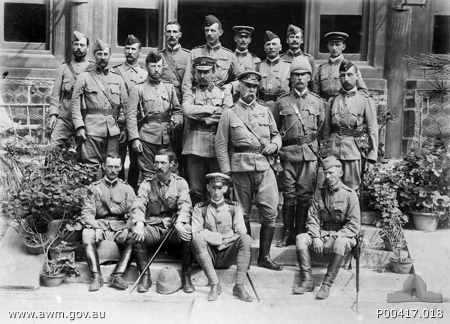<Back to Index>
- British Minister to China Claude Maxwell MacDonald, 1852
- General of the British Indian Army Alfred Gaselee, 1844
PAGE SPONSOR


Colonel Sir Claude Maxwell MacDonald GCMG GCVO KCB PC (1852 – 1915) was a British diplomat, best known for his service in China and Japan.
MacDonald was educated at Uppingham School and Sandhurst, and was a soldier - diplomat, commissioned into the 74th Foot in 1872. He thought of himself as a 'soldier - outsider', as regards the Foreign Office.
His early career was in Africa. He served in the Egyptian campaign of 1882, from 1887 to 1889 was consul general at Zanzibar, and then served some years as consul general at Brass in the West African Oil Rivers Protectorate, where in 1895 he was an observer of the rebellion of King Koko of Nembe.
In 1896, MacDonald was appointed British minister to China. He was also the British Minister to Korea in 1896 through 1898.
In China, MacDonald obtained a lease at Weihaiwei, and obtained railway contracts for British syndicates. He was instrumental in securing the Second Peking Convention, by which China leased to Britain the New Territories of Hong Kong.
In 1899 he was the author of a Note which proposed a new demarcation of the border between China and British India in the Karakoram and Kashmir, now known as the Macartney - Macdonald Line, which still forms the basis of the border between China and Pakistan and the line of control between China and India.
As a military man, MacDonald led the defense of the foreign legations in 1900 which were under siege during the Boxer Rebellion, and he worked well with the Anglophile Japanese Colonel Shiba Goro.
MacDonald presided over the Tokyo Legation in years of harmony between Britain and Japan (1900 – 12), swapping posts with Sir Ernest Satow who replaced him as Minister in Peking. On January 30, 1902, the first Anglo - Japanese Alliance was signed in London between the Foreign Secretary Lord Lansdowne and Hayashi Tadasu, the Japanese Minister. MacDonald was still in Tokyo when the alliance was renewed in 1905 and 1911. He also became Britain's first ambassador to Japan when the status of the legation was raised to an embassy in 1905.
MacDonald was made a Privy Councillor in 1906.


Sir Alfred Gaselee, GCB, GCIE, (3 June 1844 – 29 March 1918) was a soldier who reached the rank of General in the British Indian Army.
Gaselee was born at Little Yeldham, Essex, the eldest son of the Reverend John Gaselee, rector of Little Yeldham, and his wife, Sarah Anne Mant. He entered Felsted School in 1853 and Sandhurst in 1861.
In 1882, Gaselee married Alice Jane, daughter of the Rt. Hon. William Edward Baxter, from whom he obtained a divorce in 1893. He married Alice Margaret, daughter of Gartside Gartside - Tipping of Rossferry, County Fermanagh, Ireland, on 20 August 1895, who outlived him. There were no children from either marriage.
Gaselee was commissioned as an ensign in the 93rd regiment (later the Sutherland Highlanders) on 9 January 1863. He was involved in the campaign on the North - West Frontier of India in that year. He was promoted lieutenant on 11 October 1866, transferred to the Bengal staff corps, and joined the 4th Punjab infantry on 27 September 1867. He went with the Indian force to Abyssinia, where he acted as assistant to the director general of transport and was present at the capture of Magdala (13 April 1868). He was promoted captain on 9 January 1875, and served with the Jowaki expedition of 1877 – 78. In the Second Anglo - Afghan War, he was a deputy assistant quartermaster general, and accompanied Lord Roberts on the march from Kabul to the relief of Kandahar. He was made a brevetted major on 2 March 1881.
Gaselee was promoted to major on 9 January 1883, and lieutenant colonel on 9 January 1889, and was made a Companion of the Order of the Bath (CB) on 19 November 1891. On 27 September 1892, he was promoted to the command of the 1st battalion, 5th Gurkha rifles. On 1 February 1893, he was promoted to colonel and appointed aide - de - camp to Queen Victoria. He served in the Isazai expedition (1892), the Waziristan field force (1894 – 95), and the Tirah campaign (1897 – 98). For his services in Tirah, Gaselee was created a Knight Commander of the Order of the Bath (KCB) on 20 May 1898. From 25 July 1898 to 3 June 1901, he served simultaneously as quartermaster general at Simla and brigadier general commanding Bundelkhand district. He was promoted to major general on 3 July 1900.
In the summer of 1900, when the Boxer Uprising in China was at its height, Gaselee was chosen to command the British element in the international expeditionary force. A large force was to have been assembled under the German commander, Count Von Waldersee, consisting, in addition to British, of Japanese, Russian, Italian, French, American and German troops. Before Von Waldersee's arrival news broke that the foreign legations in Peking were still holding out. Gaselee was therefore put in command of a smaller force of 20,000 men, mostly Japanese and Russian, but including 3,000 British and Indian troops, which set out for Peking immediately. The 7th Rajputs, under Gaselee himself, were the first troops to enter Peking, reaching the legations on the afternoon of 14 August 1900. The international rivalries between the component parts of the relieving forces might have given rise to the most serious complications. Gaselee showed tact and firmness in his handling of a very delicate situation. As a reward for his services, he was created Knight Grand Commander of the Order of the Indian Empire (GCIE) on 24 July 1901.
Gaselee was promoted lieutenant general on 30 June 1903 and full general on 30 June 1906. From 30 June 1903 to 29 June 1908, he was commander of the forces in Bengal. He then retired to Guildford. He was created a Knight Grand Cross of the Order of the Bath (GCB) on 25 June 1909 and was colonel of the 54th Sikhs from 13 May 1904 until his death, which took place at Grove End House, 12 Pit Farm Road, Guildford, GU1 2JH, on 29 March 1918.